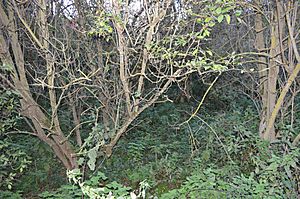Castle Lime Works Quarry facts for kids
| Site of Special Scientific Interest | |
 |
|
| Area of Search | Hertfordshire |
|---|---|
| Interest | Geological |
| Area | 1.6 hectares |
| Notification | 1986 |
| Location map | Magic Map |
Castle Lime Works Quarry is a special place in Hertfordshire, near South Mimms. It's a 1.6-hectare (about 4-acre) area that has been recognized as a Site of Special Scientific Interest (SSSI) because of its amazing geology. This site used to be a quarry where people dug out chalk. It was officially protected in 1986 under a law called the Wildlife and Countryside Act.
What Makes This Quarry Special?
This old chalk quarry is very important for understanding Earth's history. Experts like Natural England say it shows something unique:
- It has "extensive piping" at the top of the chalk. This means there are tube-like holes filled with clay.
- These pipes formed when water dissolved the chalk. This happened where the chalk meets older sediments from a time called the Tertiary period.
- Scientists believe these features developed over millions of years, during the Tertiary and Pleistocene periods.
- It's considered the best example in England of these clay-filled pipes in chalk landscapes, known as "Chalk Karst."
A Look at the Geology
Imagine a giant sponge made of chalk. Over long periods, water can slowly dissolve parts of it, especially where different types of rock or soil meet. At Castle Lime Works Quarry, this happened where the chalk met much older layers of sediment. As the chalk dissolved, it created these "pipes" or channels. Later, these channels filled up with clay, preserving a unique record of how the land changed over time.
The "Tertiary" period was a long time ago, starting about 66 million years ago. The "Pleistocene" period came much later, starting about 2.6 million years ago and ending around 11,700 years ago. So, the features you see here took millions of years to form!
Visiting the Site
It's important to know that Castle Lime Works Quarry is on private land. This means there is no public access to the site. It's protected so that scientists can study its unique geological features without disturbance.

